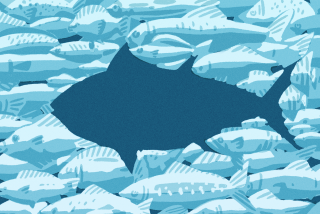OUTDOOR NOTES : Sorry, Charlie, It’s Not a 400-Pounder
- Share via
The 400-pound yellowfin tuna remains at large, but for how long?
The waters off the Revillagigedo Islands’ this season are producing so many giant yellowfins that many believe it’s only a matter of time before the ultimate goal of this specialized sport--a 400-pounder--is boated.
Already, more than a dozen yellowfins have tipped the scale at more than 300 pounds, and several have pushed 350. Last week alone, three boats returned to San Diego with two fish apiece at 300 pounds or better.
The biggest yet is a yellowfin measuring 87 inches, 67 in girth, landed after a long fight by two fishermen aboard the Qualifier 105.
“It sounds like a box, doesn’t it?” said John Klein, owner of the vessel.
Skipper John Grabowski, using a formula designed to estimate the fish within about 10% of its actual weight, calculated the fish at 417 pounds. There was celebration aboard the Qualifier 105.
“My heart stopped when he said that,” said Canoga Park’s John Carbone, who hooked the fish after a brief tropical rain last Tuesday morning.
Rather than wait the several days it would have taken to get the fish back to San Diego, during which it would have lost weight because of dehydration, Grabowski radioed ahead to the Red Rooster III, which had left the area a day earlier, and had skipper Bob Burns leave his digital scale at Cabo San Lucas--about 200 miles north of the islands.
“They just wanted to break the 400-pound barrier,” Burns said. “I don’t care how we do it, we all want to do that.”
The Qualifier pulled into Cabo San Lucas last Thursday and the fish tipped the scale at 386 pounds. When the vessel pulled into San Diego on Sunday, the fish’s weight was down to 377.
So Carbone didn’t get the 400-pounder. Even so, he and companion Jim Labanowski had landed the third-largest yellowfin ever on rod and reel, and the largest ever to put up a fight worthy of a large tuna.
“It was up one side, around the anchor, back around the anchor, back down the other side, across the stern, up the other side and it went like that for the rest of the fight, to the point where I knew I was going to have a rough time with it,” said Carbone, 36.
“When they told me, ‘John, you’re turning white’ and my knees were shaking a little bit, I said, ‘OK, give it to Jim,’ and Jim Labanowski finished it off,” Carbone said.
But only after the fish had pulled him off his feet and nearly over the rail.
“I would have been gone, except Mike Gallagher, one of our three amigos, grabbed a hold of my harness and pulled me back in the boat,” said Labanowski, 42.
Most large yellowfins, including the all-tackle world record, a 388-pound 12-ounce fish, are taken at night when they are less willing to make extended runs in the dark water under the lights.
“In the day, they can see where they’re going,” Burns said.
Briefly
SALTWATER--The local fleet has, for the most part, shifted its entire operation to bottom-fishing for rock cod and rockfish, or to the kelp beds, where they have had some success with calico bass.
Cabo San Lucas: Weather and water conditions are ideal. Striped marlin are the primary target as the fish filter down from the Magdalena area. Dorado and wahoo are hitting trolled lures.
San Jose del Cabo: Victor’s panga fleet is reporting more striped marlin, as the fish seem to be following the mackerel north into the Sea of Cortez. But there are fewer dorado. Still, some fishermen are finding both.
East Cape: Blue marlin are still being taken occasionally, but dorado, sailfish and tuna are the prevalent species.
Loreto: Yellowtail season is in full swing, the bite termed “wide open” when weather permits. The fish are averaging 18-23 pounds, biting near San Bruno and Polpito reefs. Cabrilla and roosterfish are showing regularly as well.
NEW REGULATIONS--Of note to Southland and Eastern Sierra fishermen for 1992-94: Black-bass anglers at the Haiwee Lakes in Inyo County will be limited to a two-fish daily bag limit after February of 1992; Hodges Lake in San Diego County will require anglers to release black bass smaller than 15 inches; because of an over-abundant brook trout population, anglers will be allowed to take up to 10 brook trout daily if they are under eight inches. Exceptions to this offer, over the next two years, are Kirman Lake in Mono County (continued from the preceding regulations) and Red Lake in Alpine County. Tributaries to Big Bear Lake will be open only from the Saturday preceding Memorial Day through Feb. 28 to protect spawning rainbow trout.
MEMORIAL--More than 300, including personnel from four fire departments, attended memorial services for Bob Bringhurst, a widely known angler, who was killed during a holdup Dec. 7. Bringhurst, 49, was a former L.A. County fireman and paramedic. A $10,000 reward has been offered for information leading to the arrest and conviction of his killer.
HUNTING--Gary R. Ingersoll of Houston has won the 1991 Weatherby Big Game Trophy. Ingersoll has hunted in 48 countries on six continents, taking 174 species and 152 record book animals. . . . The California black bear hunt is expected to meet its quota of 1,250 before the season expires Dec. 29. As of Tuesday, 1,155 tags had been returned. About 12,000 of the maximum 15,000 tags have been sold. . . . Raahauge’s Pheasant Hunting Club in Norco is holding a variety of shoots Sunday from 9 a.m. to dark, with proceeds to benefit duck habitat. Details: (714) 735-2361.
More to Read
Go beyond the scoreboard
Get the latest on L.A.'s teams in the daily Sports Report newsletter.
You may occasionally receive promotional content from the Los Angeles Times.










